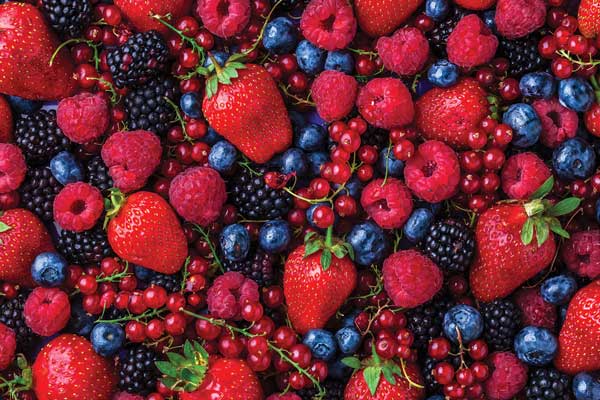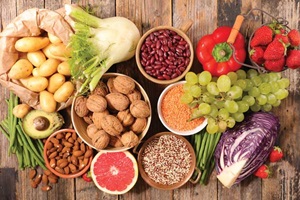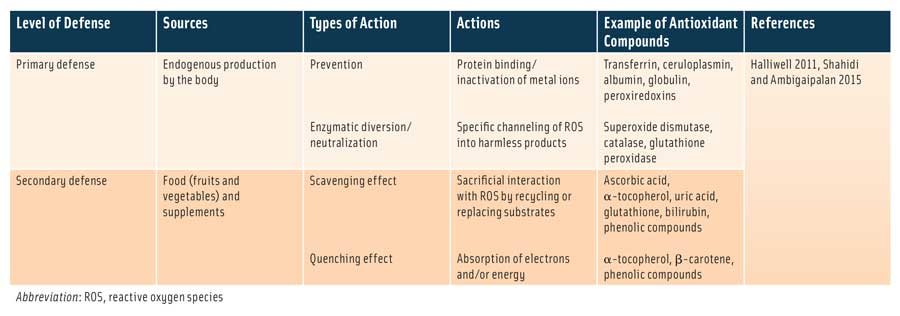
Weighing the Benefits of Dietary Antioxidant Supplements
As the science of antioxidants and pro-oxidants continues to progress, we are learning more about the effects of supplement dosages, the interaction between antioxidants and free radicals, and the role of free radicals in immune response and health.
Article Content
Evidence is building that consumption of large doses of dietary antioxidant supplements may not always render beneficial health effects, and some may even have a negative effect. Firstly, the role of free radicals causing various chronic diseases is not yet fully clear. There are also some beneficial actions conferred by free radicals in human physiology. Secondly, antioxidant capacity in the body coupled with the immune system may resist the action of dietary antioxidants. Lastly, the dosage of antioxidants taken may be inappropriate.
In addition, low to moderate levels of pro-oxidants might sometimes be better in stimulating the endogenous antioxidant enzyme defense system for overall human health. Consumption of natural foods rich in antioxidants such as fruits, vegetables, nuts, and grains, among others, may provide a better option for health promotion compared to taking high dosages of dietary antioxidant supplements.
Antioxidant Supplementation
Antioxidant supplementation, either as tablets/capsules or in foods, is based on the notion that reactive oxygen species (ROS) and other free radicals contribute to many human diseases by causing oxidative stress, and that decreasing oxidative damage may help to prevent their occurrence. Therefore, the assumption that antioxidants are good for health and that consuming antioxidants will improve health is commonly accepted by the general public. The supplement industries use these concepts to market their products, which have been viewed as safe, health-promoting molecules to be taken as mega-doses (Bast and Haenen 2013; Halliwell 2011, 2012). Hence, antioxidant-enriched foods, drinks (usually rich in sugars and coloring agents), cosmetics, and supplements are being advertised and marketed extensively.
However, some of the latest research findings advise against routine consumption of dietary antioxidant supplements. There are various reputable studies, including meta analyses, systematic reviews, observational studies, and human intervention trials which demonstrate no beneficial effect of multi-vitamin or multi-mineral antioxidant supplements on all-cause mortality, cancer, cardiovascular diseases (CVD), and cognitive functions (Angelo et al. 2015, Bjelakovic et al. 2013, Fortmann et al. 2013, Kuszak et al. 2016, Myung et al. 2013, Ye et al. 2013). Moreover, it was found that β-carotene, vitamin E, and possibly high doses of vitamin A supplements may be associated with higher all-cause mortality. This happens because β-carotene and vitamin E have been shown to be pro-oxidants in the human body when taken at high doses, at least in some populations (Vrolijk et al. 2015). Most supplements do not prevent non-communicable diseases (NCDs) or death (Angelo et al. 2015, Bjelakovic et al. 2013, Cohen 2016, Fortmann et al. 2013, Kuszak et al. 2016). This is especially true for the healthy general population with no obvious evidence of nutrient deficiency.
The Role of ROS in Health
The general public has the mind-set that free radicals or ROS are bad; hence antioxidants must be good. Actually, it’s excess free radicals that are bad over the human life span since they contribute to aging, cancer, and neurodegenerative diseases (NDD), such as dementia and Alzheimer’s disease (Bast and Haenen 2013, Poljsak et al. 2013). In some recent reviews (Bast and Haenen 2013; Halliwell 2011, 2012), several misconceptions about antioxidants and free radicals in human physiology were discussed. There are several reasons why these antioxidants may fail to show benefits to humans.
Firstly, free radicals may not be the main cause in some NCDs. Humans have a well-balanced pool of free radicals and antioxidants that allow some free radicals to perform useful functions while eradicating oxidative damage physiologically. An example is the role ROS play in killing pathogens as part of the human innate immune system. ROS participate in the immune system by killing some infectious microorganisms. Phagocytes use ROS to kill pathogens in innate immunity (Halliwell 2011, Imlay 2008). In addition, it has been reported that stem cells need some free radicals to function properly; however, excess free radicals may impair their function (Juntilla et al. 2010). Further, free radicals help to prevent the immune system (especially the T-lymphocytes) from over-activation due to prolonging inflammation once the threat has been eliminated (Hultqvist et al. 2009). In fact, chronic inflammation is the major determinant of various NCDs later on during life.
Secondly, the overall antioxidant defense in the human body depends on endogenously-synthesized antioxidant enzymes such as reduced glutathione (GSH), catalase, peroxiredoxins, and superoxide dismutase (SOD), which serve as the primary defense, whereas diet-derived antioxidants (vitamins A, C, E; minerals; and phenolic compounds) are categorized as secondary defense (Bast and Haenan 2013, Halliwell 2011). Table 1 depicts the classification of different antioxidant defense systems in the human body based on their mechanism(s) of action. The antioxidant defense system must, thus, minimize the levels of the most harmful ROS on the one hand, while still allow the presence of a sufficient amount of ROS for their useful purposes, such as cell signaling and redox regulation. Cells can tolerate mild oxidative stress where this stress can help to up-regulate cellular repair processes and other protective systems. Therefore, it will be more effective if the antioxidant defense system is stimulated with some weak or mild pro-oxidants or free radicals; this will, in turn, stimulate the level of endogenous antioxidants in the body, such as GSH and SOD to fight infections (Halliwell 2011).
On the contrary, overconsumption of antioxidants could down-regulate important endogenous antioxidant enzymes, depress parts of the immune system or the normal cellular protective responses to oxidative stress (Bast and Haenen 2013, Poljsak et al. 2013). Moderate rather than mega-consumption of antioxidants (in the form of tablet or capsule) is still recommended, but antioxidants may often serve as a double-edge sword in that at high levels they may render a pro-oxidant effect, both in food and in the body as it has been observed for α-tocopherol.
 ROS have been shown to be the culprit for the development of cancer and sometimes even help to cure it (Halliwell 2011, 2012). Exercise is well known to be beneficial for humans because it is a mild pro-oxidant challenge that stimulates beneficial adaptation in skeletal muscles (Jackson 2011). Oxygen itself is a free radical, and a slow killer, yet humans cannot live without it. Free radicals have played an essential role in the evolution of plants and animals. Plants produce oxygen during photosynthesis where they adapt themselves to live by producing their own antioxidants (some vitamins, minerals, and phytochemicals) to overcome the serious oxidative damage. This process of adaptation is well-known as evolution (Halliwell 2011). All these suggest that some mild pro-oxidants might play a positive role in health promotion compared to the intake of massive amounts of antioxidants (Bast and Haenen 2013).
ROS have been shown to be the culprit for the development of cancer and sometimes even help to cure it (Halliwell 2011, 2012). Exercise is well known to be beneficial for humans because it is a mild pro-oxidant challenge that stimulates beneficial adaptation in skeletal muscles (Jackson 2011). Oxygen itself is a free radical, and a slow killer, yet humans cannot live without it. Free radicals have played an essential role in the evolution of plants and animals. Plants produce oxygen during photosynthesis where they adapt themselves to live by producing their own antioxidants (some vitamins, minerals, and phytochemicals) to overcome the serious oxidative damage. This process of adaptation is well-known as evolution (Halliwell 2011). All these suggest that some mild pro-oxidants might play a positive role in health promotion compared to the intake of massive amounts of antioxidants (Bast and Haenen 2013).
Insensitivity of Human Physiology to Dietary Antioxidants
The positive attributes of antioxidants have been primarily based on cell culture experiments where effective chemical scavenging activity of antioxidants in cell culture led to extrapolation of a protective potential in vivo. In fact, it has been demonstrated that several misleading studies might have provided potentially erroneous information concerning the positive effects of certain antioxidant molecules. It has been reported that the effects of antioxidants, such as carotenoids and phenolic compounds on cell culture, can be deemed as artifacts where the results should be interpreted cautiously (Halliwell 2008). Limited information is available on the absorption, distribution, metabolism, and excretion of these antioxidants in humans, especially about their bioaccessibility and bioavailability (Shahidi and Ambigaipalan 2015). More research should be carried out to determine the metabolites of these antioxidant compounds after urinary excretion coupled together with cellular models such as caco-2 in order to obtain more qualitatively well-correlated results with human intervention trials. These data are essential for demonstrating the true biological relevance of these compounds in the context of food supplement, nutrition, and human health (Shahidi and Ambigaipalan 2015).
The response of different individuals to antioxidant supplementation may vary considerably, depending on their diet and oxidation. It is also important to note that antioxidants may perform better in decreasing oxidative damage in animal models than in human patients (Loke et al. 2010). It seems that the human antioxidant defense system resists modulation by dietary antioxidants, while the laboratory rats and rabbits appear to be more sensitive to the administered dietary antioxidants (Loke e al. 2010). Perhaps, our insensitivity as humans calls for the development of better and newer antioxidant supplements (Bast and Haenen 2013, Halliwell 2011).
Importance of Dietary Dosage of Antioxidants
The dosage of administered dietary antioxidants may not always be adequate as this often exceeds the recommended daily allowances (RDA) when used as a supplement. Thus, lower doses and/or mixtures of antioxidants are superior to higher doses of single agents (Bast and Haenen 2013, Halliwell 2011). For example, consumption of foods rich in vitamin C was shown to decrease oxidative damage physiologically, whereas the intake of vitamin C alone at high dosage did not. In this relation, a study demonstrated increased plasma vitamin C level by 60% after daily supplementation with 500 mg of vitamin C for 6 weeks. However, the pro-oxidant activity of vitamin C was noticed as significantly higher levels of 8-oxoadenine in DNA were present in blood lymphocytes (Podmore et al. 1998). In fact, the use of vitamin C at a dosage of 1,000 mg for optimal health far exceeded the RDA of 75–90 mg/day (Institute of Medicine 2000).
Vitamin E, in the form of α-tocopherol, becomes a pro-oxidant at high concentrations (> 700 ppm), both in food and in the body (Shahidi and de Camargo 2016). Resveratrol, a stilbene with high antioxidant capacity, has a pro-oxidant effect in the presence of copper (de la Lastra and Villegas 2007). It is well known that every compound has negative effects if overdosed. This is the same for antioxidants. The consumption of high doses of antioxidants could be the main reason for the increased toxicity reported, leading to pro-oxidant effects or “antioxidative stress” (Poljsak and Milisav 2012).
In reality, certain antioxidant supplements demonstrate positive effects and good efficacy. Many supplements, including vitamins, minerals, and other functional ingredients such as probiotics, are important components of modern healthcare (Cohen 2016). Supplements are important in preventing vitamin and mineral deficiencies, and some studies have demonstrated that a specific combination of vitamins and minerals can delay progression of early age-related macular degeneration (Angelo et al. 2015). However, supplements that are useful in treating certain conditions are frequently overused among the general population to improve or maintain health (Cohen 2016, Kuszak et al. 2016). Significant attention needs to be paid to the dosages of all the supplements consumed.
 Importance of Antioxidants from Natural Sources
Importance of Antioxidants from Natural Sources
Consumption of different fruits, vegetables, nuts, and grains helps maintain good health and delay disease occurrence (Slavin and Lloyd 2012). The intake of 3–5 servings of fruits and vegetables daily would protect against NCDs, such as coronary heart disease (CHD), cancer, NDD, and diabetes (Slavin and Lloyd 2012). This is due to the fact that fruits and vegetables are chemically complex, where their health benefits could arise from the overall effects of several compounds or mixtures of components present, including vitamins, minerals, fiber, and bioactive phytochemicals. This mechanism is known as synergistic action where the observed effects exceed the sum of individual effects in complex biological systems (Shahidi and Ambigaipalan 2015).
Isolating individual compounds and using them in large quantities to imitate the benefits of whole foods might not be a good idea after all. This is because the isolated compounds may either lose their bioactivity or may not behave the same way when present in whole foods. For example, β-carotene as an isolated compound increases the risks of cancers among smokers. However, β-carotene from food sources acts differently and is an effective and helpful antioxidant (Vrolijk et al. 2015). The notion of “Let food be thy medicine and medicine be thy food” advocated by Hippocrates some 2,500 years ago is still relevant today. It is a known fact that all foods are functional since they provide flavor (taste and aroma), nutrients, and bioactives (Shahidi and Ambigaipalan 2015). More importantly, plant foods such as fruits and vegetables are low in calories, the main concern of a majority (Slavin and Lloyd 2012). Therefore, why not consume more fruits, vegetables, nuts, and grains for good health?
Balancing Free Radicals and Antioxidants
Most humans are able to maintain their set points of oxidative stress regardless of additional dietary antioxidant supplementation (Poljsak et al. 2013). On the contrary, antioxidant supplements do appear to be effective in lowering oxidative stress if its initial level in the body is higher than the normal set point of endogenous homeostatic regulation. Thus, the antioxidant supplements may help the organism to balance the high levels of oxidative stress which is above the level that could be controlled by endogenous antioxidant defense systems. Hence, the balance between free radicals and antioxidants should be optimal and there is an urgent need to determine the individual’s oxidative stress level before administering the supplement (Poljsak et al. 2013). However, the reference values for typical oxidative stress status of individuals are yet to be established. Biomarkers that are robust and reliable must be carefully selected (Bast and Haenen 2013). Although this area has advanced considerably, there are still no conclusive answers even though the evidence is sufficient to advise against routine supplementation. Much remains to be discovered regarding the biological effects of antioxidants in our body. The scientific community is expecting more exciting results in the future with the advances in research findings and hopefully authoritative recommendations.
An understanding of why dietary antioxidant supplements do not always benefit human health remains a target of research. There is a lot to be discovered regarding the biological effects of antioxidants in the human body. Perhaps we are still at a stage not too late to inform individuals that excessive intake of antioxidants may not necessarily be good for health. Thus, natural foods containing antioxidants such as fruits, vegetables, nuts, and grains, coupled with regular exercise, may help maintain optimum health and prevent the onset of NCDs. High-dose antioxidant supplements may not always benefit human health, while moderate presence of pro-oxidants in the body may sometimes be helpful for stimulating the overall immune response to external hazardous compounds.
Sui Kiat Chang, a member of IFT, is assistant professor, Dept. of Nutrition and Dietetics, School of Health Sciences, International Medical University, Kuala Lumpur, Malaysia ([email protected]). Cesarettin Alasalvar, a member and Fellow of IFT, is director of Food Institute/associate professor, TÜBITAK Marmara Research Center, Food Institute, Gebze-Kocaeli, Turkey ([email protected]). Fereidoon Shahidi, a member and Fellow of IFT, is university research professor, Dept. of Biochemistry, Memorial University of Newfoundland, St. John’s, NL, Canada ([email protected]).
Latest News

Better Juice and Ingredion Collaborate and More Ingredient News
News about food industry suppliers

How to Formulate for Food Intolerances
In this column, the author describes the global prevalence of food intolerances and provides insight into state-of-science ingredient replacement and removal methods when formulating gluten-free and lactose-free foods.

Top 10 Functional Food Trends: Reinventing Wellness
Consumer health challenges, mounting interest in food as medicine, and the blurring line between foods and supplements will spawn functional food and beverage opportunities.

Production Capacity Expands for Food to Fight Malnutrition
Production capacity for ready-to-use therapeutic food Plumpy’Nut at Edesia expands thanks to a Bezos family donation.

Natural Product Expo West Attention-Getters: Highlights From the Event
Food Technology Contributing Editor Linda Milo Ohr reports on trends she tracked at Natural Products Expo West 2024.


